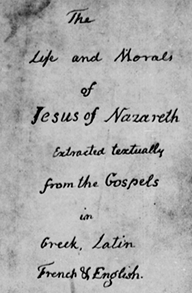 Jefferson rejected the "divinity" of Jesus, but he believed that Christ was a deeply interesting and profoundly important moral or ethical teacher. He also subscribed to the belief that it was in Christ's moral and ethical teachings that a civilized society should be conducted. Cynical of the miracle accounts in the New Testament, Jefferson was convinced that the authentic words of Jesus had been contaminated. In 1820 he conducted what practicing Christians consider to be blasphemy. He completed an ambitious work titled "The Life and Morals of Jesus of Nazareth Extracted Textually from the Gospels in Greek, Latin, French and English."
Jefferson rejected the "divinity" of Jesus, but he believed that Christ was a deeply interesting and profoundly important moral or ethical teacher. He also subscribed to the belief that it was in Christ's moral and ethical teachings that a civilized society should be conducted. Cynical of the miracle accounts in the New Testament, Jefferson was convinced that the authentic words of Jesus had been contaminated. In 1820 he conducted what practicing Christians consider to be blasphemy. He completed an ambitious work titled "The Life and Morals of Jesus of Nazareth Extracted Textually from the Gospels in Greek, Latin, French and English." Using a razor and glue, Jefferson cut and pasted his arrangement of selected verses from a 1794 bilingual Latin/Greek version using the text of the Plantin Polyglot, a French Geneva Bible and the King James Version of the gospels of Matthew, Mark, Luke, and John in chronological order—putting together excerpts from one text with those of another to create a single narrative. The text of the New Testament appears in four parallel columns in four languages. Jefferson omitted the words that he thought were inauthentic and retained those he believed were original. The resulting work is commonly known as the "Jefferson Bible."
No supernatural acts of Christ are included. Jefferson viewed Jesus as strictly human. He also believed that Jesus Himself ascribed to a more deistic belief system. In a letter to Benjamin Rush, he wrote: “I should proceed to a view of the life, character, and doctrines of Jesus, who sensible of incorrectness of their ideas of the Deity, and of morality, endeavored to bring them to the principles of a pure deism.” (April 9, 1803). Jefferson also completely denied the resurrection. The book ends with the words: “Now, in the place where He was crucified, there was a garden; and in the garden a new sepulchre, wherein was never man yet laid. There laid they Jesus. And rolled a great stone to the door of the sepulchre, and departed.”
Jefferson described the work in a letter to John Adams dated October 12, 1813: “In extracting the pure principles which he taught, we should have to strip off the artificial vestments in which they have been muffled by priests, who have travestied them into various forms, as instruments of riches and power to them…We must reduce our volume to the simple evangelists, select, even from them, the very words only of Jesus, paring off the Amphibologisms into which they have been led, by forgetting often, or not understanding, what had fallen from him, by giving their own misconceptions as his dicta, and expressing unintelligibly for others what they had not understood themselves. There will be found remaining the most sublime and benevolent code of morals which has ever been offered to man. I have performed this operation for my own use, by cutting verse by verse out of the printed book, and arranging the matter which is evidently his, and which is as easily distinguishable as diamonds in a dunghill. The result is an 8vo of 46 pages of pure and unsophisticated doctrines.”
In a letter to Reverend Charles Clay, he described his results: “Probably you have heard me say I had taken the four Evangelists, had cut out from them every text they had recorded of the moral precepts of Jesus, and arranged them in a certain order; and although they appeared but as fragments, yet fragments of the most sublime edifice of morality which had ever been exhibited to man.” Most historians feel that Jefferson composed the book for his own satisfaction, supporting the Christian faith as he saw it. He did not produce it to shock or offend the religious community; he composed it for himself, for his devotion, and for his own personal assurance.
After completion of the Life and Morals, about 1820, Jefferson shared it with a number of friends, but he never allowed it to be published during his lifetime. The most complete form Jefferson produced was inherited by his grandson, Thomas Jefferson Randolph. The entire original Jefferson Bible is available to view, page-by-page, on the Smithsonian National Museum of American History's website. The high-resolution digitization enables the public to see the minute details and anomalies of each page. Read Here
- Michael Aubrecht
Updated: Tuesday, 8 November 2022 5:15 PM EST
Post Comment | Permalink | Share This Post